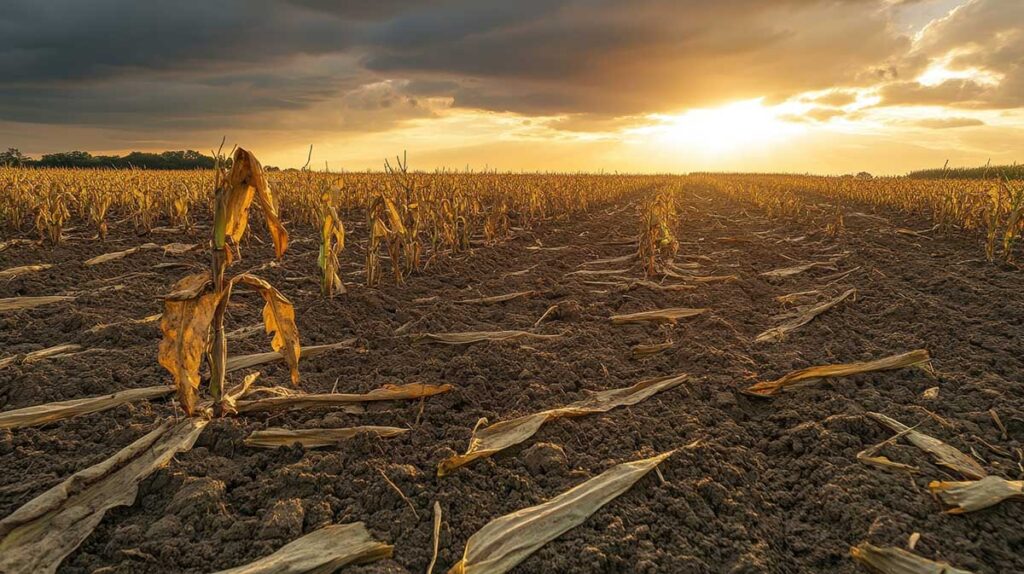Crop failures are one of the biggest risks faced by rural producers and can have an impact on their income and, consequently, on the assets they have built up over the years.
The unpredictability of harvests requires producers to adopt strategies to protect their assets and ensure the continuity of their activities.
Check out the details of the issue and some legal alternatives for dealing with crop failures!
What is a crop failure?
Crop failure occurs when the agricultural production of a given crop does not reach the expected volume, whether due to climatic factors, pests, diseases or other adversities.
This phenomenon can result in significant productivity losses, affecting producers’ income and the supply of food on the market.
Depending on the severity, crop failures can jeopardize farmers’ financial sustainability, as well as impacting the entire production chain and the regional economy.
Main causes of crop failures
Normally, the causes of crop failures are linked to environmental factors and uncertainties in production itself. We’ve listed the main causes, check them out!
- Climatic factors
Drought: a lack of rainfall during critical periods can drastically reduce crop yields
Excessive rainfall: on the other hand, heavy or out-of-season rainfall can cause flooding, soil erosion and make planting and harvesting difficult
Large temperature fluctuations: extremely low or high temperatures can damage or destroy plants, especially those in sensitive stages of development
Hail: falling hail can cause physical damage to plants, destroying leaves, flowers and fruit
- Pests and diseases
Infestations of insects, fungi, viruses and other pests can devastate crops, compromising production. Failure to control these pests and diseases effectively and quickly can result in significant losses.
- Soil conditions
Excessive use of chemicals or prolonged monoculture can deplete the soil’s nutrients, making it less productive.
- Farm management problems
Inefficient planning: errors in crop planning, such as the improper choice of crops or inadequate planting techniques, can lead to low productivity.
Insufficient use of technology: lack of investment in agricultural technology can limit the ability to respond to challenges such as pests or adverse weather conditions.
- Economic and political factors
Sudden changes in the prices of agricultural inputs, such as seeds and fertilizers, can limit farmers’ ability to invest in production.
In addition, a lack of government support, insufficient subsidies or policies that disadvantage the agricultural sector can exacerbate producers’ difficulties.
Impacts on the economy and producers
Crop failures can have an impact on both rural producers and the country’s economy.
For producers, crop failures result in a significant loss of income, since the reduction in agricultural production directly affects revenue, making it difficult to pay operating costs and make new investments.
This scenario can lead to indebtedness, as producers face difficulties in honoring financial commitments, which can generate a cycle of growing debts and, in extreme cases, the loss of property or even bankruptcy.
In addition, crop failures compromise producers’ assets, who often have to sell assets such as land or machinery to cover the losses, jeopardizing the long-term sustainability of their operations.
With fewer resources available, producers’ ability to invest in new technologies and quality inputs is reduced, which can perpetuate low productivity in future harvests.
In the country’s economy, crop failures can lead to an increase in food prices, due to the reduced supply on the market. This puts pressure on inflation and affects the population’s purchasing power, especially for essential items.
As the agricultural sector is a significant part of the Brazilian economy, the phenomenon can negatively affect the Gross Domestic Product (GDP), hindering economic growth.
The trade balance can also be impacted, since the reduction in agricultural production reduces exports, affecting the country’s trade balance.
Legal alternatives to crop failures
Faced with the risks and impacts associated with crop failure, there are some legal alternatives that rural producers can consider to mitigate the damage and protect their assets.
- Rural insurance
Rural insurance is one of the main tools for protecting against losses caused by crop failure. It covers losses resulting from adverse weather events, pests, diseases and other factors that compromise production.
By taking out rural insurance, producers can guarantee compensation that helps offset some of the losses, allowing them to continue their activities and maintain their assets.
Renegotiating debts
In the event of a crop failure, producers can try to negotiate with financial institutions to revise the payment conditions for debts contracted for costing or investments.
Renegotiation can include extending deadlines, reducing interest or restructuring the amount owed, relieving financial pressure on the producer.
- Judicial recovery
In situations of severe financial crisis or in cases where direct negotiation with suppliers is not possible, rural producers can apply for judicial recovery as a way of restructuring their debts and avoiding bankruptcy.
Judicial recovery allows for the suspension of foreclosures and the renegotiation of debts with creditors, giving the producer the chance to reorganize his finances and preserve the agricultural operation.
- Rural credit
Rural credit can also be a tool to help producers overcome the difficulties caused by crop failures.
When a crop failure occurs, rural credit can be used to guarantee the continuity of agricultural operations, making it possible to buy inputs, pay for labor and maintain productive activities.
Want to know more? In the guide “Rural credit: how can access be made easier for agricultural producers?”, you will learn about the possibilities that can help rural producers and agri-business owners overcome bureaucratic barriers and obtain credit more efficiently.te.









